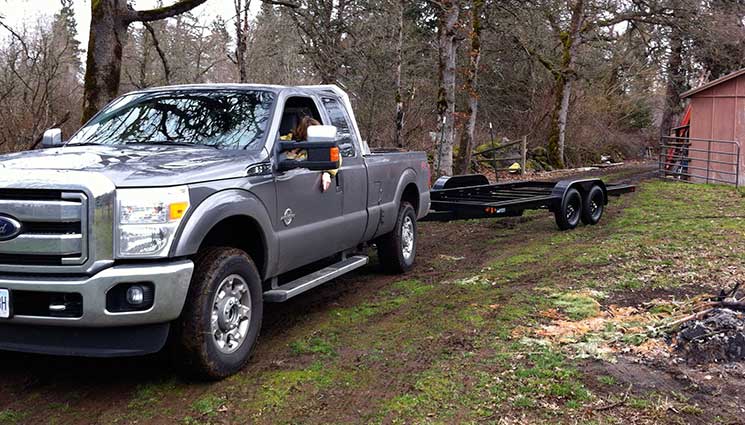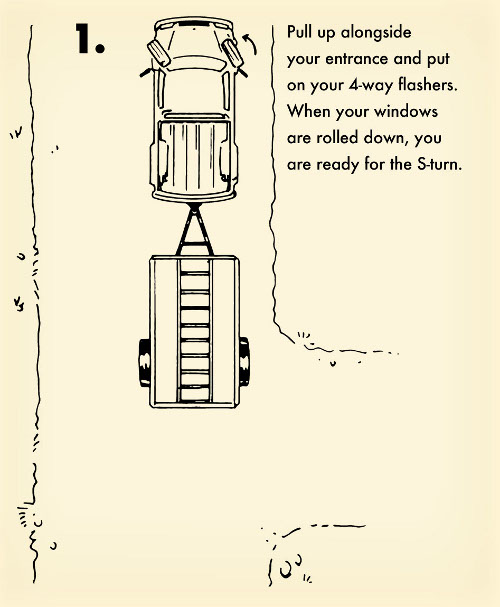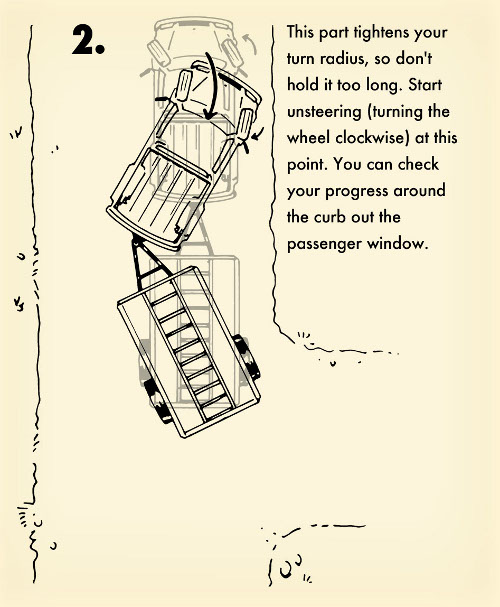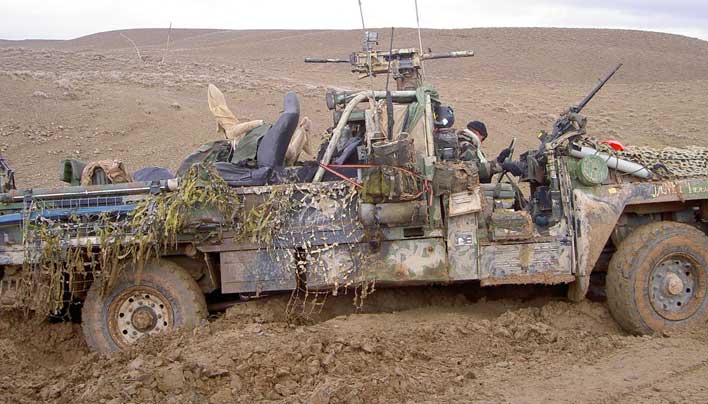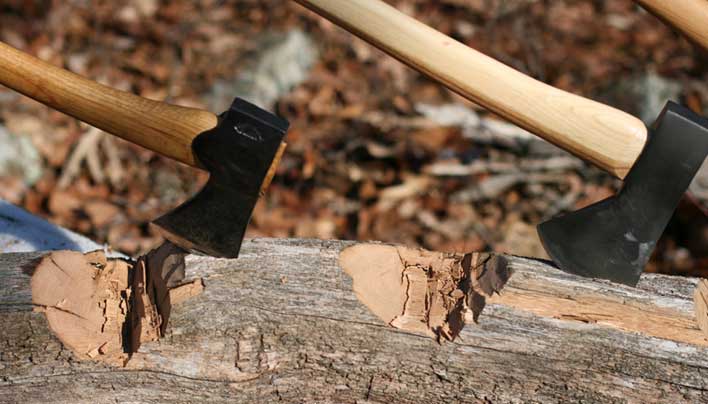How To Back Up A Trailer
A lot of people plan to bug out if the SHTF with all of their survival gear stowed in their vehicle or pulled in a trailer. What if you have to turn around quickly? Do you know how to swing that trailer around so that you don’t get stuck? Can you execute a turn on a blocked road so that you aren’t trapped in an ambush?
This is what I was thinking as I watched my neighbor this weekend. I was mowing our yard which is my favorite twice weekly activity this time of year (not) and my neighbor was working in his yard. He had hauled a little potting soil for some plants he was planting in a small trailer attached to the back of his SUV. The trailer was one of the less substantial types, perfectly suited for small jobs like hauling a washer and dryer but as he finished I watched him drive up the street to turn around. He pulled into a driveway and attempted the first backup. It was obvious he hadn’t given himself enough room or the trailer wasn’t straight enough and it quickly was wedged at a 90 degree angle to his car.
I watched him attempt this a couple of additional times and then finally, he stopped the car, got out and unhitched the trailer. It was when he unhitched the trailer that he realized that he had stopped on a hill and he quickly started jogging down the hill all the while trying to navigate his trailer into a position where he could back up his SUV, reattach and go back home.
What if this was you and you had hundreds, maybe thousands of pounds of stored food, ammunition, tarps, generators and survival gear piled onto the trailer. Could you turn this around without getting out of your car? How many attempts would you have to make to get the trailer and your vehicle pointed in the right direction? Could you do this under duress?
Backing up a trailer isn’t hard, but it does take practice. I like to lump this into the same category as sweating pipe. The concept itself is simple, but unless you know how to finesse the materials you will probably screw it up a couple of times. This is the main reason why I go ahead and call a plumber if I decide to get my handy-man hat on and mess around with anything on the back side of the wall in our bathroom or kitchen. If I ever build a new house I swear everything will be PEX.
Backing up a trailer is easier to do if you can see your trailer in my opinion, but that is probably because I don’t have any other experience. I do know that we have some professional truck drivers who follow this blog who are probably laughing right now and I am counting on for their comments below.
The Approach
Backing a trailer into a specific spot at a specific angle is mostly in the set-up. Like most things, preparation is key.
First things first: roll down your windows. Driver’s side and passenger’s, and it doesn’t matter if it is raining. If you have a passenger, it is best to kick them out before you even approach the actual boat launch, driveway, or campsite. You are probably going to want a spotter anyway, and they will either distract you or block your view if they stay in.
Forget about your rear view mirror, and don’t turn around and try to look out the back window. Chances are, you can’t see much over your trailer, and who cares what the front of that trailer is doing? You want to make sure your side mirrors are adjusted properly, because they are going to show you where the sides of your trailer are, allowing you to deduce what the back is doing. It may be more showy to do the big turn around and hug the back of the seat thing, but how much cooler to pull up and back that baby in without turning around? Appearances aside, it really is the proper way to do it. Proper mirror adjustment means when your rig is straight, your trailer is visible in about the inside third of your mirror. It is good to be able to see your trailer tires. This gives you a good view of where you are going and how you are doing.
Now you are almost ready to approach. For the sake of a consistent example, let’s say you are backing a camper into a campsite. It is coming up on your right-hand side. Stop short and get out of your truck. Go check for obvious obstacles that you will have to avoid. Don’t forget to look up. Even if you have a straight shot to the back of the site, will you clear all the tree branches? This sounds like retentive health and safety advice, but backing over a stray chunk of firewood or someone’s leftover wire roasting stick is going to be a rough start to your weekend. Try to make a mental map of where the picnic table is in relation to the fire pit and the back of the site. Pace off distances if you need to (you do know how wide your camper is, don’t you?). Have your passenger(s) stand near major obstacles so they can shout if you are too close. You may not always be able to see them, but your windows are already rolled down, right?
The Right Set-up
The moment of truth is at hand. If you do this next part wrong, it doesn’t matter much what you do after. Get it right, and you will look like a pro. It is the S-turn. You are in a forward gear with your campsite coming up on the right. Get that vehicle over to the right as far as you can without hitting something or rolling into the ditch and pull up alongside the entrance. How far along you go really depends on how long your rig is and what kind of hitch you have, but probably somewhere around when your truck bumper is coming up on the far end of the entrance, you want to swing out left. Don’t go all the way. Before you drive into the left side ditch, crank it back to the right. This will make the smaller angle between the truck and trailer be on the right-hand side. Stop with your truck somewhere around midway between road shoulders. Congratulations, your trailer is ready and begging to be backed into the sweet spot.
The Moment of Truth
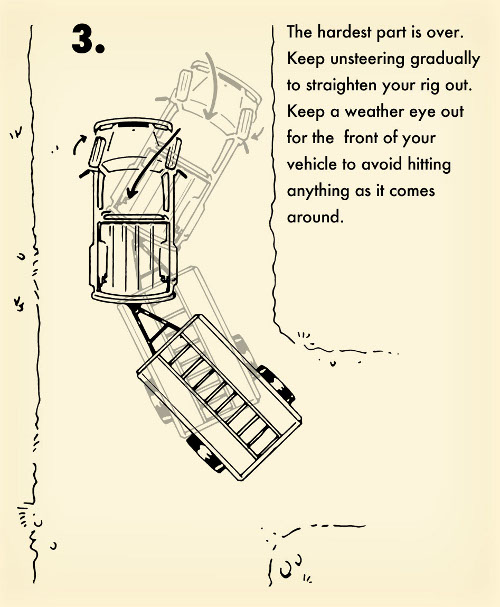
The next part is where everyone gets nervous. People will offer “helpful” advice here, about how the steering wheel works in reverse now, but I’ve seen people start thinking everything in their vehicle works backwards and forget which pedal does what. So, take a deep breath and imagine you are a kid playing with toy trucks. You will probably need to make your turn angle a bit sharper, especially if you have a narrow entrance or a longer trailer. To accomplish this, turn your wheels as though you were going to steer to the left if you were going forward. Don’t turn it all the way. Put the truck in reverse, and let off the brake. Stay really calm at this point and constantly ask yourself “Is the right thing happening at this instant?” If the answer is yes, don’t change anything. As soon as the answer is “No,” stop. You aren’t going fast (I hope), and hopefully you didn’t choose a busy spot for your first attempts.
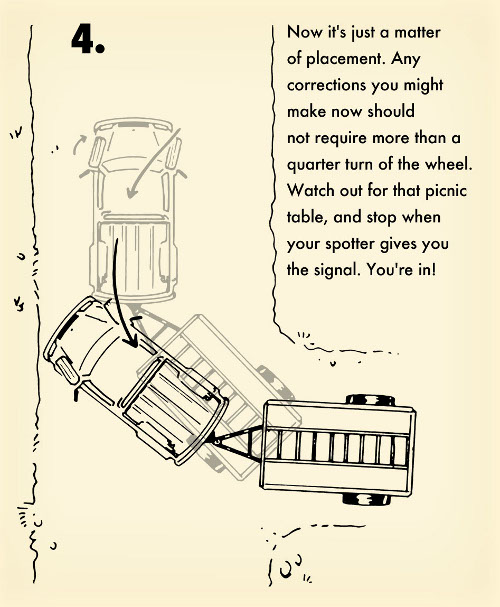
So, you are in reverse, with your wheels pointed left, causing your trailer to turn sharper. You won’t be able to keep that up for long before you fold your rig like a jack knife. It only takes a little distance to do what you need here. It is kind of like putting a crease in a piece of paper, where you only need that instant of pressure to kink it over. After that, you can lighten up and it will stay. So, after a couple feet (literally), start turning the wheel to the right. Think of following the trailer with the truck. My trainer always told me once I had the kink to “follow the trailer around.” Turning your wheel to the right will begin to straighten out the whole rig. I always think of it as “unsteering.” How soon you do this, and how sharply you turn depends on the relative sizes of everything. One of the biggest mistakes people make in reverse is over-correction. If the trailer starts going one way or the other, don’t crank the wheel all the way over. Unless you are in a really technical spot, needing to crank the wheel more than 180 degrees probably means you need to pull ahead and try again. Never shout when a whisper will do.
Words of Warning
Throughout this exercise, keep an eye on what the front of your truck is doing. Watch for ditches and obstacles. I once blew a steer tire on a set of stairs because I was too focused on the back end. This is another reason to back up like a man, using your mirrors, not wrapped around your seat trying to see out the back window.
Don’t be afraid of taking multiple runs to get into your spot. Obviously it is better to take a few runs and get it right than to hit something first shot. Some spots require multiple runs no matter how good you are. Also, don’t be afraid to put it in park, get out, and walk around to see what the back end is doing and how close you are to that fire pit. I did this constantly, even once I had some skill and confidence.
A word is necessary here about having someone “guide” you into a spot. Don’t. Having people to help is great, but give them specific jobs. Just like you have a limited perspective from the driver’s seat, they will have a limited perspective on what the far side of the trailer is doing. Tell your helper something like, “Stand so you can see my face in the side mirror of the truck and let me know if it looks like I’m going to hit the fire pit.” If they can’t see you, you can’t see them. Give them a specific signal that is verbal (your windows are still rolled down, right?) and visual. Inexperienced guides will usually run eagerly to the back of the trailer and start waving incomprehensibly while standing somewhere you can’t see and then yell after you’ve run over the picnic table.
Please practice this before you get to the boat launch with your new boat. Get your wife or your kids to come out and practice spotting you while you back up. How great will it be to pull up and have everyone know what to do? Don’t be that guy with the shiny new boat weaving and winding your way down the boat launch stressing everyone else out.
A lot of people plan to bug out if the SHTF with all of their survival gear stowed in their vehicle or pulled in a trailer. What if you have

